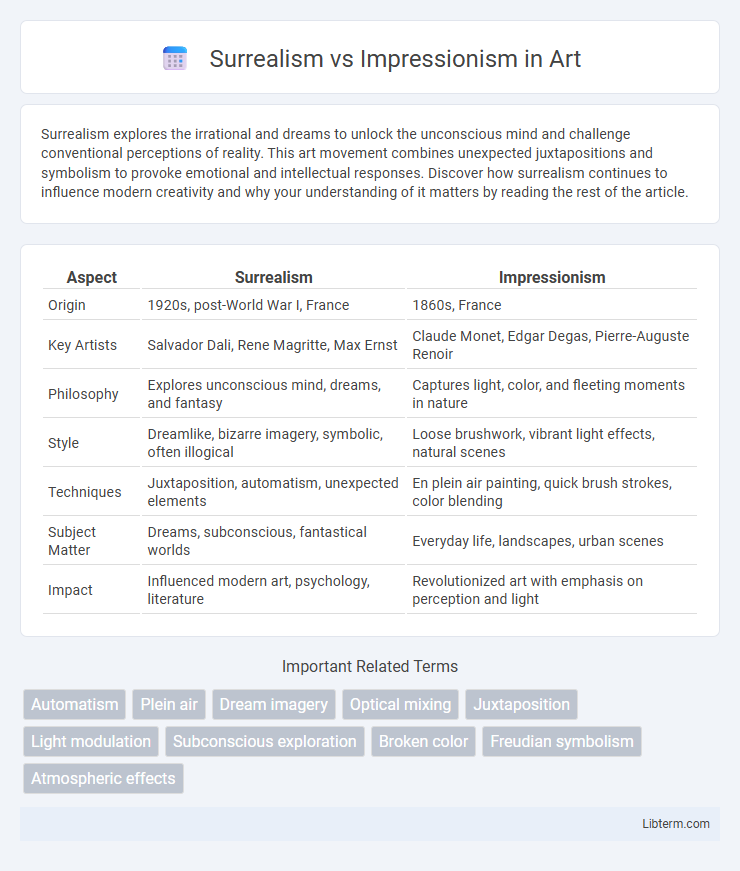Surrealism explores the irrational and dreams to unlock the unconscious mind and challenge conventional perceptions of reality. This art movement combines unexpected juxtapositions and symbolism to provoke emotional and intellectual responses. Discover how surrealism continues to influence modern creativity and why your understanding of it matters by reading the rest of the article.
Table of Comparison
| Aspect | Surrealism | Impressionism |
|---|---|---|
| Origin | 1920s, post-World War I, France | 1860s, France |
| Key Artists | Salvador Dali, Rene Magritte, Max Ernst | Claude Monet, Edgar Degas, Pierre-Auguste Renoir |
| Philosophy | Explores unconscious mind, dreams, and fantasy | Captures light, color, and fleeting moments in nature |
| Style | Dreamlike, bizarre imagery, symbolic, often illogical | Loose brushwork, vibrant light effects, natural scenes |
| Techniques | Juxtaposition, automatism, unexpected elements | En plein air painting, quick brush strokes, color blending |
| Subject Matter | Dreams, subconscious, fantastical worlds | Everyday life, landscapes, urban scenes |
| Impact | Influenced modern art, psychology, literature | Revolutionized art with emphasis on perception and light |
Introduction to Surrealism and Impressionism
Surrealism, emerging in the early 1920s, focuses on unlocking the unconscious mind through dream-like, illogical scenes often blending reality with fantasy. Impressionism, developed in the late 19th century by artists like Claude Monet, emphasizes capturing light and natural moments using loose brushwork and vibrant colors. Both movements revolutionized art by challenging traditional techniques and perceptions, yet Surrealism delves into psychological depths while Impressionism celebrates sensory experiences.
Historical Origins and Artistic Context
Surrealism emerged in the early 1920s as a response to the disillusionment following World War I, heavily influenced by the psychoanalytic theories of Sigmund Freud and the desire to unleash the unconscious mind through dream-like, fantastical imagery. Impressionism originated in the late 19th century Paris, developed by artists like Claude Monet and Pierre-Auguste Renoir, focusing on capturing the fleeting effects of light and color in everyday scenes through loose brushwork and open composition. Surrealism's artistic context emphasized the irrational and subconscious, contrasting with Impressionism's aim to depict sensory impressions and the natural environment with spontaneity and immediacy.
Key Philosophies and Ideological Foundations
Surrealism centers on unlocking the unconscious mind to explore dream-like imagery and irrational juxtapositions, emphasizing the power of imagination and the subconscious as sources of truth. Impressionism focuses on capturing transient effects of light and color to depict sensory experiences and the immediacy of perception, rooted in a philosophy of observing the natural world with spontaneity and realism. The ideological foundation of Surrealism challenges rational thought and convention, whereas Impressionism embraces empirical observation and the ephemeral nature of visual reality.
Signature Techniques and Styles
Surrealism employs dream-like imagery and illogical scenes, utilizing techniques such as automatism, collage, and unexpected juxtapositions to explore the subconscious mind. Impressionism focuses on capturing light and natural scenes with short, broken brushstrokes, vibrant colors, and an emphasis on atmospheric effects and fleeting moments. Surrealist works often feature distorted realities and symbolic content, while Impressionist paintings highlight sensory impressions and the play of natural light.
Influential Artists and Iconic Works
Surrealism, championed by artists like Salvador Dali with his iconic work "The Persistence of Memory," emphasizes dreamlike scenes and irrational juxtapositions. Impressionism, led by Claude Monet and exemplified in "Impression, Sunrise," captures fleeting light and natural landscapes with loose brushstrokes and vibrant colors. Both movements revolutionized art by challenging traditional techniques and exploring new visual experiences.
Representation of Reality and Imagination
Surrealism redefines reality by merging dreamlike imagination with unexpected juxtapositions, challenging the boundary between consciousness and subconsciousness. Impressionism captures fleeting moments and sensory effects, emphasizing natural light and color to portray reality as perceived in the present moment. While Impressionism focuses on visual impressions of the external world, Surrealism delves into the inner psyche, presenting a distorted and symbolic representation of reality.
Use of Color, Light, and Composition
Surrealism employs bold, often unnatural colors and dramatic contrasts of light to evoke dreamlike, subconscious experiences, using unexpected compositions that challenge reality. Impressionism focuses on capturing natural light and its effects on color, utilizing softer, fragmented brushstrokes and open compositions to depict fleeting moments and atmospheric conditions. The use of color in Impressionism prioritizes natural hues and tonal variations, while Surrealism embraces symbolic and fantastical palettes to convey psychological depth.
Impact on Modern Art Movements
Surrealism revolutionized modern art by introducing dream-like imagery and exploring the unconscious mind, influencing movements such as Abstract Expressionism and Pop Art. Impressionism's emphasis on light, color, and everyday scenes paved the way for modern techniques in capturing reality and shifted artistic focus towards subjective perception. Both movements challenged traditional representation, shaping diverse approaches to creativity and artistic expression in the 20th century.
Critical Reception and Legacy
Surrealism challenged traditional artistic norms with its dreamlike, subconscious imagery, initially receiving mixed critical reception but ultimately influencing modern art, literature, and psychoanalytic theory profoundly. Impressionism, celebrated for its innovative use of light and color, faced early criticism for its departure from realism but later gained widespread acclaim and fundamentally transformed perceptions of visual representation. Both movements left enduring legacies by reshaping artistic expression and inspiring diverse creative fields globally.
Comparing Surrealism and Impressionism: Key Differences and Similarities
Surrealism and Impressionism differ significantly in artistic approach and thematic focus; Surrealism explores the unconscious mind through dreamlike, fantastical imagery, while Impressionism captures fleeting moments with light and color to depict reality's sensory experience. Both movements revolutionized art in their respective periods, emphasizing personal perception over traditional representation. Despite contrasting techniques, they share a common goal of breaking conventional boundaries to evoke emotional and psychological responses.
Surrealism Infographic

 libterm.com
libterm.com